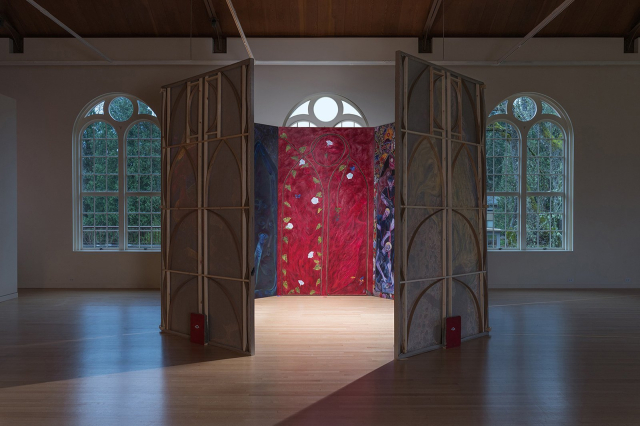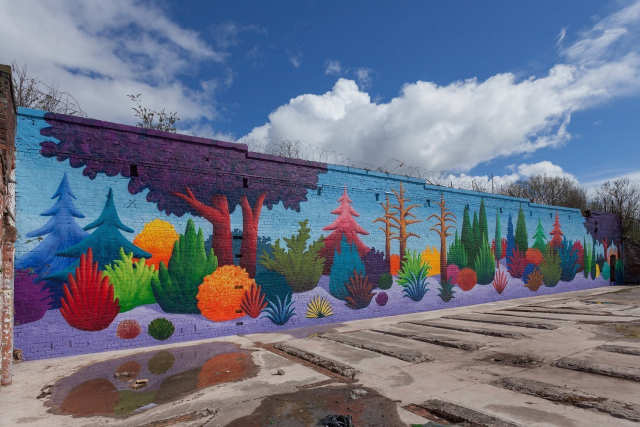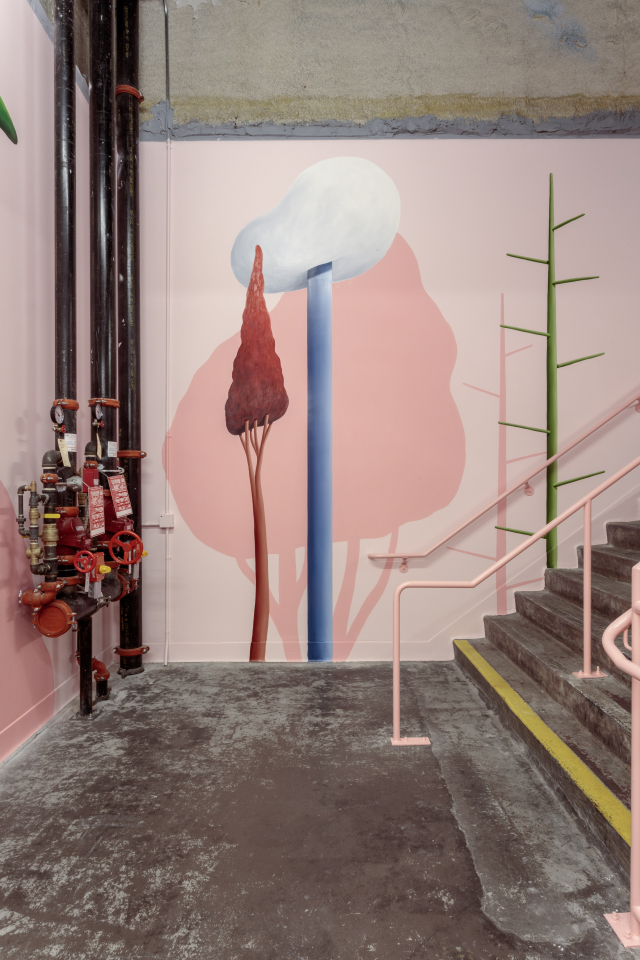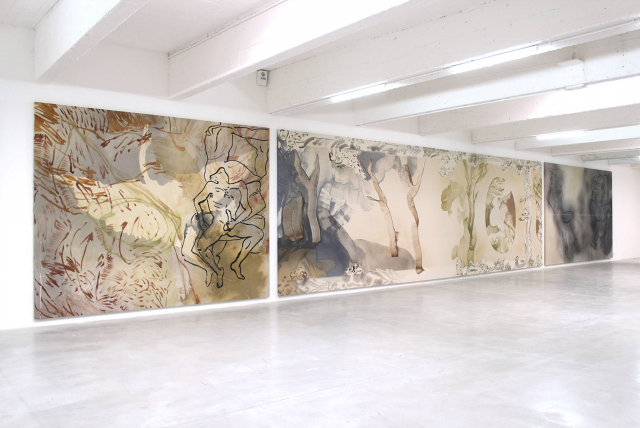Grand contemporary pictorial cycles: an open survey
Who is painting today’s Scrovegni Chapel? Here is some artists who have painted pictorial cycles comparable to those that have made the history of art.
After developing the idea that history of painting hinges upon grand (also dimension wise) pictorial cycles (from Giotto’s Cappella Scrovegni to the Michelangelo’s Sistina, or to back to decorating cycles in Romanesque architecture we extensively wrote about); and given that monumental-format works have often come to embody the highest ambition of the artists who painted them – let’s think for instance of the Water Lilies cycle that Claude Monet donated to the French state just after the end of World War I, or of Guernica by Picasso, or of the less notorious Blue Room by Francesco Clemente – we have attempted to approach the contemporary art scene from this angle to find out those artists who are taking up this ‘challenge’ of the history that is creating contemporary monumental paintings; the sought-after reward is, for the artwork, to be called a masterpiece.
Sam Falls and the California Flora: a contemporary pictorial cycle.
During the last edition of Art Basel the pictorial cycle of nine paintings presented by Sam Falls at Unlimited have caught the attention of many viewers. All the works are titled California Flora (National Forest Condensation Wall, North to South). The Los-Angeles based artist usually writes himself the introductory texts to his most important works, hence: ‘This body of work depicts the unique and rich collection of national forests in California, where almost every type of landscape environment can be found. […] The works are installed from north to south read from left to right, so at the top there is the Six Rivers and Lassen, drawing a line down through the national forests of California to the southern paintings on the right of the Angeles, San Bernardino, and Cleveland National Forests. Together they represent the diversity of a state and a nation and a silent testament to nature around the world and the hope for its preservation in a changing political and global climate’. You can’t help but thinking about Monet and the donation he made. The eyes follow closely. Similarly the two artists employ a de-saturated and airy painting albeit using very different techniques. Falls places en plain air the material on a canvas covered with pure pigments and lets the atmospheric moisture photographically capturing the shape. Like Monet, also Falls is looking for the lightness of the impression while proceeding according to episodes which are ideally linked together and thought to bring the viewer into the painting. At this point, it doesn’t really matter whether the cycle will ultimately be divided due to market’s reasons. It has been conceived and indeed presented as a unity and thus will remain in the production of the artist.

Vittorio Brodmann, Enough people to fill a canoe.
Vittorio Brodmann is known for being an artist who, when painting, expresses himself at best in small-format paintings. Yet, in occasion of his solo exhibition at Kunsthalle Bern in 2016, he presented a successful painting – a quasi pictorial cycle – which was 12.5m long and 2.2m high. Is ‘Enough people to fill a canoe’ a masterpiece? Probably it is. Not quite for its dimension, but rather as it proves that Brodmann’s pictorial language – so elusive and intangible, yet sharp and universal at once – was able to evolve on larger canvases. Actually, it becomes even more effective, as it often happens with figurative painting. If anything, the matter is to find the most suitable conditions for the artwork to fulfil itself.

Wade Guyton, Mark Rothko and Francesco Clemente’s Indigo Room.
Indeed, besides being the result of a commission, the great pictorial cycles from the past could be successfully carried out as the place they were destined for temporarily became the artist’s studio. Let’s bear in mind that to paint large canvases it is necessary to have wide enough spaces, at least when it comes to figuration; in this regard Wade Guyton had an easy ride. Despite presenting monumental pictorial cycles in every museum he has been hosted up to now (Ludwig, Whitney, Kunsthalle Zurich, Punta della Dogana), Guyton has always worked with pieces that were assembled on site and dismantled when the show ended. As far as expressiveness is concerned, the outcome is extraordinary, even though it must be said that when it comes to non-iconic art, as in Guyton’s case, it is very, perhaps even too difficult to make mistakes. On the contrary, it is much harder for abstract artists to be effective with the small formats. Not even Gerhard Richter can do it.
When talking about Mark Rothko, as De Lillo does in Cosmopolis, the chapel commissioned by John and Dominique de Menil in 1971 remains the cornerstone of the artist’s production. This is because the great pictorial cycles can’t generally be commodified, as De Lillo himself remarks: ‘they belong to humanity’. The Indigo Room by Francesco Clemente, which as a matter of fact is a pictorial environment which was conceived to entirely decorate the room where it was exhibited, was composed in Madras between 1983 and 1984, in the garden of his friend Prema Srinivasan. There Clemente could find everything that was necessary to stain hand-woven cotton strips with indigo. Tthe work belongs to an Italian private collector and has been shown only in occasion of the first comprehensive museum retrospective dedicated to Francesco Clemente at the Guggenheim NY in 1999. The year before Clemente painted a big fresco in the loft of Julian and Jacqueline Schnabel (Mice, Rice, Dice). We assume that the work is still there. In 1982 Clemente completed The Fourteen Stations, a monumental cycle of 12 canvases for a total of almost 270 square meter of pictorial surface, which entered a private collection and never reappeared on the market.
The Revelation Theatre by Srijon Chowdhury.
In this context we would also include the Revelation Theatre, a cycle of seven large canvases that Srijon Chowdhury painted in 2017 (here is the link to our writing about Srijon Chowdhury). Like the majority of the works we have talked about so far, also these ones convey a great deal of spirituality, not only by offering symbols, archetypal figures or simply formal impulses, but also by becoming an environment, thus an experience. There aren’t literal references to the Book of Revelation, only allusive ones – that is the same approach taken by another talented emerging artist, Mona Osman, who’s painting also delves into topics such as spirituality and religion (here is the link to our writing about Mona Osman). Chowdhury’s series is made of seven paintings, like the seven Churches St. John writes to, but that’s pretty much it in terms of similarities. The revelation is a path within everyday life as well as a monition to one’s destiny. The interpreters of the prophecy belong to our own present (and to the artist’s past). The angels of death are men armed with rifles, yet they kill with spears; the beasts are more disturbing than frightful. The dream catcher introduces an external cultural element, associated with Native American cultures, hence transforming the universality of the apocalyptic message into a personal event, which is possibly summed up in the female figure who rides the green horse. Reflecting on the end occurs through suggestive double-arched windows that painting, transformed into a Gothic window, unveils through a light which necessarily comes from outside. The idea of being inside something, like a theatre (more than a religious building), or a womb thus becomes stronger. The reference to the birth is not only to be found in the panel where a group of veiled women looks after (prays?) the newborn, but also in the womb-like shape that appears, with Cyclopean eye, in the panel titled ‘Cycle’. After all, the Revelation is but an eternal return.

Nicolas Party, Matthew Lutz-Kinoy, Maxwell Alexandre.
The frozen spirituality that lingers in Nicolas Party’s landscapes is of a completely different nature. This artist has in many instances directly brought painting onto architectural surfaces, rarely ascribing a main role to this kind of works. So much so that most of his wall paintings have actually been deleted. It didn’t happen in 2013 in Glasgow, Scotland, when the artist, in occasion of a project called Walled Garden Party, painted a mesmerising landscape over thirty meter long, and six meter high that is still there. And it will not happen at the Marciano Art Foundation in Los Angeles, where the artist created a site-specific four story mural throughout the MAF stairwell. Both of the works are permanent, but most of the wall paintings Party has been painting are merely passing episodes, aimed at reinforcing the pastel-effect more than at having their own life. This is possibly what distinguishes the artist, whose ambition when creating a grand pictorial cycle is indeed to produce artworks with in(de)finite time-frame. There seems to be the same ambition in the the painting of Matthew Lutz-Kinoy or Maxwell Alexandre. We talked about this latter one lately, in occasion of his first solo show in an European institution (here is the link dedicated to Maxwell Alexandre). This may be enough to expect an important cycle coming up at some point. Of the former, we should certainly mention his exhibition at Le Consortium in Dijon, titled Southern Garden of the Château Bellevue which took place in 2018. Lutz-Kinoy has explicitly tried to create a unique and immersive artwork, yet divided into more levels, drawing inspiration from New York’s great fine arts collections, starting from the Metropolitan and the Frick Collection in Manhattan. And from two artists who despite being far away in time, are somehow similar, like Caroleen Schneemann and Francois Boucher – Lutz-Kinoy was certainly influenced by the room dedicated to Boucher by the Frick Collection, and to the ‘bucolic fantasies’ this evokes.


2019. Courtesy Marciano Art Foundation. Photography © Charles White JWPictures.com.

To be continued…
December 18, 2019
